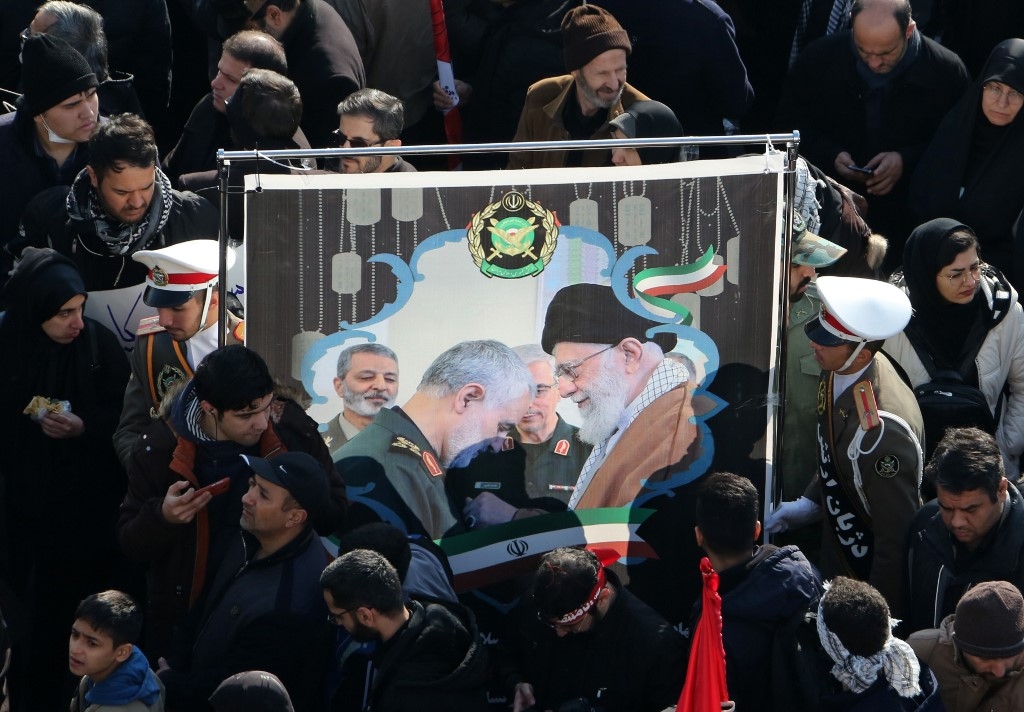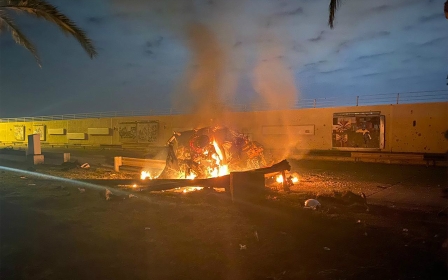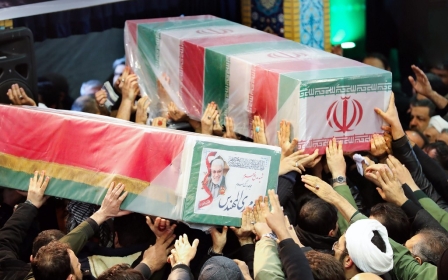The surprise was not Soleimani's death, but the unity it fostered

On 3 January, the new year began not only with a violent bang, but also with a tectonic shift - and not the one that anybody expected.
The surprise was not the US air strike on Qassem Soleimani, who commanded Iran’s Quds Force, the foreign operations unit of Iran’s Islamic Revolutionary Guards Corps, but rather the reaction to it.
Soleimani’s death was not unexpected. He was a soldier who survived the devastating Iran-Iraq War. His military career continued well after the end of the war in 1988, and he eventually became the Quds Force commander in the late 90s.
A 'living martyr'
Soleimani dutifully developed and implemented Iran’s regional security architecture, which evolved into the era of the Arab uprisings and the Syrian civil war. In the latter, he coordinated militias to fight alongside a depleted and exhausted Syrian army.
New MEE newsletter: Jerusalem Dispatch
Sign up to get the latest insights and analysis on Israel-Palestine, alongside Turkey Unpacked and other MEE newsletters
When the Islamic State (IS) began marching on Iraq’s cities in the summer of 2014 and eventually reached the gates of Baghdad, the world was slow to react - except for Soleimani. He was the first foreign leader on the scene to shore up resistance to IS. He commanded troops and militias not from a distant, fortified encampment, but by moving freely in the world’s most tumultuous region, where countless groups, least of all IS, vowed to kill him.
For the first time in the modern period, a political figure received burial rites in hallowed grounds in both Iran and Iraq, a watershed moment
It is thus no surprise that he ultimately fell. Iranian Supreme Leader Ayatollah Khamenei often referred to him as a “living martyr” before his death.
As with any military commander who fought in wars, Soleimani had allies and enemies. As such, there were those who welcomed his assassination - a welcome that CNN played on loop when a sparsely populated, spontaneous march in Syria's Idlib celebrated his demise.
But the real surprise was the groundswell of solidarity that his death generated. His body was not immediately returned to Iran to receive burial rites; rather, he was kept in Iraq so that regular Iraqis and the militiamen he backed could take his coffin to Iraq’s shrine cities, including Najaf and Karbala, the hallowed grounds of Shia Islam.
Throngs of Iraqis gathered to commemorate him and Abu Mahdi al-Muhandis, the leader of the Kataib Hezbollah militia who was also killed in the US strike.
Hallowed grounds
The bodies of Soleimani, Muhandis and several others were then transported to Ahvaz, an Iranian city with a history of dissent, and Kerman, where Soleimani was born and where millions gathered to pay their respect. The massive domestic shows of support underscore how foreign aggression is a red line that can bring Iranians together even after the polarisation resulting in the state’s brutal crackdown on the November protests.
More to the point, he was also taken to the shrine city of Mashhad. For the first time in the modern period, a political figure received burial rites in hallowed grounds in both Iran and Iraq, a watershed moment that cannot be overstated.
In Tehran, the bodies were placed in front of mourners who gathered behind Khamenei as he led prayers for the departed, with their coffins wrapped in Iranian and Iraqi flags. Indeed, Iran’s leader prayed in front of the colours of a country with which Iran fought the longest conventional war of the 20th century.
Again, what is surprising is not their deaths, but the manner by which Iranians and Iraqis have come together in solidarity. Despite the war of the 1980s that was very much a byproduct of Cold War politics, Iranians and Iraqis share a long history in which culture, religion and even ethnicity overlap.
Muhandis, for example, was born in Basra to an Iraqi father and Iranian mother. He married an Iranian woman after going into exile not to a fellow Arab country, but to neighbouring Iran. He returned to Iraq after the US-led invasion in 2003, and emerged as a commander during the bloodletting of the subsequent sectarian civil war.
Their killing at the hands of the US fosters a unity that speaks to a larger issue. Western media presents Iran’s role in the Middle East as an insidious foreign actor with “tentacles reaching far and wide”, as CNN’s Michael Holmes put it.
Sprawling US military infrastructure
Iran has long-standing ties with countries and communities throughout the region. The Shia communities in Iran and Lebanon have a centuries-long history, with roots in the 1500s, when the Safavid shahs imported Lebanese clerics to Iran to preach Shia Islam to their subjects.
In the 1980s, Syria was the only Arab country that sided with Iran during the Iran-Iraq war, which explains why Iran mobilised to help stave off the collapse of the Syrian government.
In the US political lexicon, Iran has “tentacles” and “proxies”, while the US merely has regional “allies” and “security interests” that encompass a military presence encircling Iran from Afghanistan to the east, Iraq to the west, and the Persian Gulf to the south.
The US has long been flooding the region with arms, and US invasions and interventions - including the recent seizure of Syrian oil fields - are naturalised within the ideological framework of a self-affirming imperial discourse. That is, US “security interests” no longer simply mean safeguarding the homeland, but also expanding and protecting the sprawling US military infrastructure overseas.
The killing of Soleimani and Muhandis, the unprecedented mourning processions in their honour, and the recent parliamentary vote in Iraq calling for a total US withdrawal, underscore the emerging unity against this ever-expanding US military presence - one that US commentators have internalised when they use a discourse that fails to realise that Iran is native to the Middle East, and the US is not.
The views expressed in this article belong to the author and do not necessarily reflect the editorial policy of Middle East Eye.
Middle East Eye delivers independent and unrivalled coverage and analysis of the Middle East, North Africa and beyond. To learn more about republishing this content and the associated fees, please fill out this form. More about MEE can be found here.







